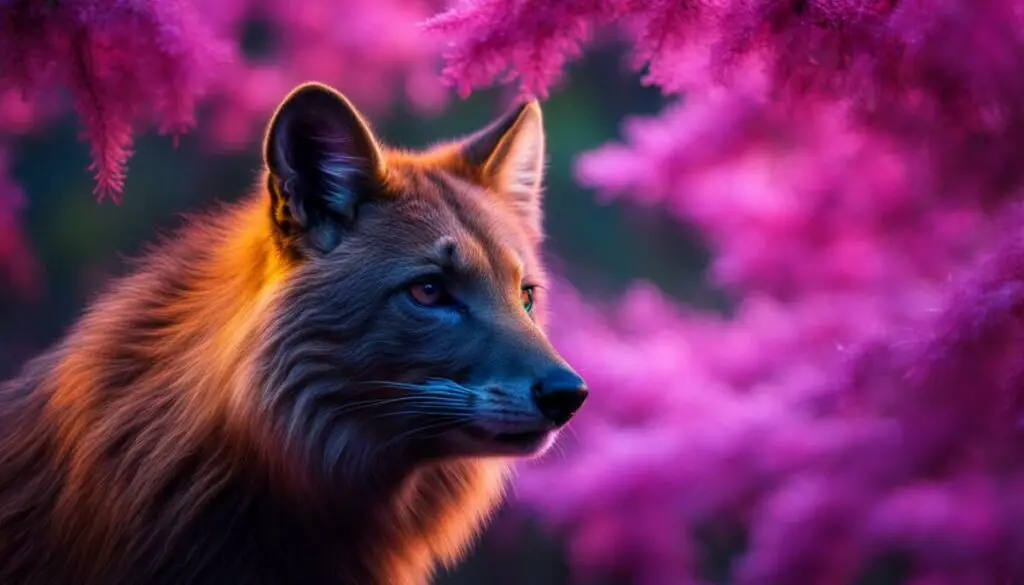Last Updated on 5 months by Francis
Animals have the extraordinary ability to see the world in ways that humans cannot even imagine. While humans see only a narrow range of colors known as visible light, animals have the incredible capability to perceive light waves beyond what our eyes can detect. This includes infrared (IR) light, which is invisible to humans but can be seen by certain animal species. Scientific studies have revealed that some animals can see infrared and ultraviolet (UV) light, unlocking a whole new realm of perception for them.
Animals perceive the world through their unique evolutionary adaptations. Their visual systems, including structures like the cornea, lens, retina, and photoreceptors, allow them to process a wider range of light waves, including infrared. In addition to infrared vision, animals also possess the incredible ability to perceive ultraviolet (UV) light. This ability gives them an advantage in various aspects of their lives, such as foraging for food, locating mates, and detecting potential threats.
Contents
Key Takeaways:
- Animals have the remarkable ability to see infrared light, which is invisible to humans.
- Their visual systems have evolved unique adaptations that enable them to perceive a wider range of light waves, including infrared and ultraviolet.
- Infrared and ultraviolet perception play vital roles in the survival and behavior of animals.
- Animals use infrared vision for locating prey, while ultraviolet perception helps with tasks such as finding nectar and selecting mates.
- Understanding animal vision expands our knowledge of the diverse adaptations present in the natural world.
The Evolution of Animal Vision
Animal vision is a fascinating subject that showcases the incredible adaptability of species to their environments. When it comes to infrared light, animals have developed unique adaptations that allow them to perceive this invisible form of light. How do animals perceive infrared light? Through specialized structures in their eyes that can detect and process the wavelengths associated with infrared light. These adaptations give animals a completely different perspective on the world, allowing them to navigate and interact with their surroundings in ways that are beyond human comprehension.
Animal adaptations to infrared light are the result of millions of years of evolution. Birds and mammals, with their complex visual systems, have specialized structures in their eyes that enable them to perceive a wider range of light waves, including infrared. These structures include the cornea, lens, retina, and photoreceptors. By having these adaptations, animals can perceive and process infrared light, giving them an advantage in hunting, communication, and survival.
One example of an animal with infrared sensitivity is the snake. Snakes have sense organs in their noses that can detect the heat-emitting infrared rays emitted by their prey. This enables them to accurately locate and capture their food. Other animals, such as frogs, bees, and some fish species, also possess infrared perception, which helps them in various ways. For instance, mosquitoes use infrared perception to detect warm areas of the body where blood flows close to the surface. These adaptations allow animals to navigate their environments and find resources in ways that we could never imagine.
Overall, the evolution of animal vision and their adaptations to infrared light are a testament to the diversity and ingenuity of nature. By perceiving a broader spectrum of light, animals have expanded their perception of the world and developed unique strategies for survival. The study of animal vision continues to uncover new insights and discoveries, shedding light on the hidden senses and wonders of the natural world.
The Marvels of Ultraviolet Vision in Animals

Animals possess incredible abilities when it comes to perceiving the world around them. One extraordinary sense that some animals have is ultraviolet (UV) vision. While humans are limited to seeing only three primary colors, animals with UV vision can perceive a fourth color that is invisible to us. This unique adaptation gives them a different perspective on the world and unlocks a hidden realm of perception.
UV perception plays a crucial role in the lives of these animals. For example, bees rely on their UV vision to track lines on flower petals, leading them directly to nectar. UV perception also aids in mate selection for certain bird species, as females use UV vision to evaluate the plumage of potential mates. By having the ability to perceive UV light, animals gain a survival advantage, allowing them to identify and interact with elements of their environment that are invisible to us.
“UV perception gives animals a survival edge, as it allows them to perceive and identify things that are invisible to us.”
Scientists speculate that this unique adaptation to UV light evolved as an advantage for these animals in various ecological contexts. It is fascinating to consider the ways in which animals perceive and experience the world differently from us, and UV vision is just one of the many wonders of nature’s vision.
Table: Animals with Ultraviolet Vision
| Animal Species | UV Vision Capability |
|---|---|
| Honeybees | Use UV vision for navigation, locating nectar, and identifying flowers |
| Birds | Use UV vision for mate selection and identifying food sources |
| Reptiles | Some reptiles, such as certain snakes and lizards, have UV vision for predator detection and prey identification |
| Butterflies | Use UV vision for finding nectar and identifying potential mates |
The ability of animals to perceive and utilize UV light is a testament to the incredible diversity and complexity of the natural world. It reminds us of the vast range of sensory experiences that exist beyond our own human perception.
Animal Eyes and Infrared Sensitivity
Animal eyes have evolved to possess remarkable abilities to detect and perceive infrared light, which is invisible to humans. These specialized adaptations enable certain animal species to navigate and interact with their environment in unique ways. For example, snakes have sense organs in their noses that detect the heat-emitting infrared rays emitted by their prey, allowing them to accurately locate and capture their target. Similarly, mosquitoes have infrared perception that helps them detect warm areas of the body where blood flows close to the surface.
Table: Examples of Animals with Infrared Sensitivity
| Animal | Infrared Sensitivity |
|---|---|
| Snake | Heat detection for prey capture |
| Mosquito | Identification of warm body areas for feeding |
| Frog | Locating insects based on their heat signatures |
| Beetle | Spotting warm and decaying matter for feeding |
By having these adaptations, animals are able to detect and respond to infrared cues that are otherwise invisible to humans. This ability gives them a significant advantage in finding food, avoiding predators, and navigating their surroundings. The study of animal eyes and their infrared sensitivity sheds light on the incredible diversity of sensory perception in the animal kingdom.
Super Slow-Mo: Animals and Time Perception

Animals perceive time in a fascinating way that differs from our human experience. Research has revealed that certain animals have the ability to perceive time at a different rate, allowing them to navigate their environment with incredible precision. Smaller animals with rapid reaction times and fast metabolisms perceive time passing more slowly than larger animals. This unique time perception gives them a competitive advantage in hunting for prey and evading predators.
For example, a small insect with a rapid metabolism may experience the world in slow motion, enabling it to react quickly and escape danger effectively. This altered perception of time allows animals to make split-second decisions and respond swiftly to changes in their surroundings.
Understanding how animals perceive time can provide valuable insights into their behavior and survival strategies. It is a testament to the incredible diversity of sensory abilities in the animal kingdom, and it highlights the wonders of nature’s intricate design.
Exploring the nuances of time perception in animals continues to be a fascinating area of research, shedding light on the intricate and highly evolved adaptations that enable animals to thrive in their environments.
The Incredible Timing of Predators and Prey
The ability of some animals to perceive time differently gives them a significant advantage when it comes to predation. Predators such as cheetahs and falcons have lightning-fast reflexes that are finely tuned to their prey’s movements. By perceiving time at a slower rate, these predators can anticipate and intercept their prey’s actions with remarkable accuracy.
On the other hand, prey animals like gazelles and birds have evolved their own time perception strategies to evade capture. They have a heightened ability to detect subtle changes in their surroundings, allowing them to react swiftly and escape from predators. These adaptations highlight the sophisticated interplay between predator and prey, where time perception plays a crucial role in the survival of both.
Unlocking the Mysteries of Slow Motion
Scientists are still unraveling the mechanisms behind animals’ altered time perception. It is believed that the unique physiological characteristics of an animal, such as the size of its nervous system and the speed of its metabolic processes, influence its perception of time.
Studying time perception in animals can provide valuable insights into the functioning of our own brains and sensory systems. By understanding how animals perceive time differently, we can gain a deeper appreciation for the intricate complexities of the natural world.
| Predators | Prey | |
|---|---|---|
| Examples | Cheetahs, falcons | Gazelles, birds |
| Advantage | Anticipate prey’s movements | React quickly to evade capture |
| Key Adaptation | Perceive time at a slower rate | Heightened ability to detect changes |
Fluorescence in Mammals: Illuminating the Unexpected

Fluorescence, once thought to be a rare and unusual trait found only in certain animals, has revealed itself to be a widespread and fundamental characteristic present in most mammals. Recent studies have shown that species ranging from lions and polar bears to scaly-tailed possums and American pikas exhibit this fascinating ability to absorb and re-emit light in different wavelengths. In fact, every mammal species examined so far has displayed some degree of fluorescence, overturning previous assumptions and leading to surprising discoveries.
To better understand the manifestation and purpose of fluorescence in mammals, researchers have studied the pigments and structures within their fur, skin, and other physical features. Unpigmented keratin, such as white fur, bare skin, quills, and claws, often fluoresces under ultraviolet (UV) light. Pigmented fur can also exhibit fluorescence, suggesting the involvement of other materials like porphyrins.
Fluorescence in mammals is not a quirk, but a widespread and fundamental trait that deserves further exploration and understanding.
Advancements in wildlife photography and optical technology have played a crucial role in capturing the mesmerizing beauty of fluorescence in animals. Through techniques like extreme slow motion, modified cameras and lenses, and non-visible wavelength capture, researchers have been able to observe and document the intricate features and behavior of these fluorescent mammals. These technological advancements have opened up new possibilities for experiencing and understanding the wonders of nature.
Illuminating the Remarkable: A Sampling of Fluorescent Mammals
| Species | Fluorescent Feature | Notes |
|---|---|---|
| Lions | Mainly whiskers and eyes | Fluorescence potentially aids in hunting and communication |
| Polar Bears | Fur, particularly around the nose and ears | Fluorescence may help with insulation and camouflaging in their Arctic environment |
| Scaly-tailed Possums | Tails and ears | Fluorescence likely serves as a form of communication and identification within their social groups |
| American Pikas | Fur, particularly in their fur-lined cheek pouches | Fluorescence may play a role in attracting mates or signaling reproductive readiness |
As our understanding of fluorescence in mammals continues to expand, we are continually reminded of the remarkable adaptations present in the animal kingdom. This unique ability to absorb and emit light in various wavelengths adds yet another layer to the already intriguing world of animal vision.
The Science of Fluorescence in Mammals
Fluorescence in mammals is a fascinating phenomenon that is primarily attributed to the presence of fluorescent pigments and structures within their fur, skin, and other physical features. This unique characteristic allows certain mammals to emit and re-emit light in different wavelengths, resulting in a mesmerizing display of vibrant colors under ultraviolet (UV) light. Unpigmented keratin, such as white fur, bare skin, quills, and claws, often fluoresces when exposed to UV light. Additionally, pigmented fur can also exhibit fluorescence, indicating the involvement of other materials like porphyrins.
The preservation and display of fluorescence in mammalian specimens is a subject of interest for researchers and museums. It is important to note that preservation methods can affect the intensity of fluorescence but do not create fluorescence where it does not exist. While preserving specimens, maintaining the optimal conditions and avoiding exposure to excessive light can help in preserving the natural fluorescence in mammals.
Research in this field provides valuable insights into the manifestation and purpose of fluorescence in mammals. By studying live animals and examining preserved specimens, scientists can delve deeper into the mechanisms behind this phenomenon and unravel its significance in the animal kingdom. The study of fluorescence in mammals opens up intriguing avenues for further exploration, inviting us to marvel at the wonders of nature’s vision.
| Fluorescent Features in Mammals | Fluorescent Pigments | Preservation Effects |
|---|---|---|
| Mesmerizing display of vibrant colors | Pigments and structures within fur, skin, and physical features | Preservation methods can affect fluorescence intensity |
| Unpigmented keratin fluorescence | Presence of other materials like porphyrins | Preservation does not create fluorescence |
| Preservation and display of fluorescence in mammalian specimens | Insights into manifestation and purpose of fluorescence | Optimal conditions and avoidance of excessive light for preservation |
Capturing the Mesmerizing Beauty of Fluorescence in Wildlife
Technological advancements in wildlife photography have revolutionized our ability to capture the mesmerizing beauty of fluorescence in animals. Through innovative techniques and cutting-edge equipment, researchers have been able to explore and document the hidden world of fluorescence in wildlife, providing us with a unique and awe-inspiring view of nature’s spectacular phenomena.
One of the remarkable developments in wildlife photography is the ability to capture extreme close-ups of animals. These close-up shots reveal the intricate details and vibrant colors of fluorescent patterns, allowing us to appreciate the stunning complexity of nature’s designs. With each photograph, we gain a deeper understanding of the adaptations and behaviors that contribute to the survival and success of these remarkable creatures.
The use of modified cameras and lenses has also played a significant role in capturing fluorescence in wildlife. By utilizing filters that allow the camera to capture light at non-visible wavelengths, photographers can unveil the hidden fluorescing pigments present in animal fur, skin, and physical features. This innovative approach has led to groundbreaking discoveries and a deeper appreciation of the hidden world of fluorescence in mammals and other species.
Unveiling Nature’s Colors: A Table of Spectacular Fluorescent Animals
| Animal | Fluorescent Feature | Fluorescent Pigment |
|---|---|---|
| Scaly-Tailed Possum | Glowing tufts of fur | Unknown |
| American Pika | Fluorescent urine markings | Porphyrins |
| Lion | Fluorescent whiskers | Unpigmented keratin |
| Polar Bear | Fluorescent nose and paw pads | Unpigmented keratin |
Table: A glimpse into the world of fluorescence in mammals, showcasing the diverse and spectacular features that have been discovered. While the specific pigments responsible for fluorescence are still being studied, their presence highlights the extraordinary adaptations found in these animals.
Conclusion
The wonders of nature’s vision are truly remarkable, and animals never cease to amaze us with their hidden senses and extraordinary abilities. From perceiving infrared and ultraviolet light to experiencing time at a different rate, animals possess a world of perception that is beyond our comprehension.
Animal perception is a complex and fascinating subject that continues to be explored by scientists and enthusiasts alike. By understanding how animals navigate, hunt, and survive, we gain a deeper appreciation for the intricate and awe-inspiring world of nature’s vision.
One of the recent astonishing discoveries is the presence of fluorescence in mammals. This widespread and fundamental trait found in most mammal species challenges our previous understanding and opens up new questions about the manifestation and purpose of fluorescence. Through advancements in photography and technology, researchers have been able to capture the mesmerizing beauty of fluorescence in animals, providing us with unique insights into their intricate features and behavior.
As we continue to explore the mysteries of nature and develop new technologies, we are constantly reminded of the incredible diversity and wonders of animal perception. The hidden senses of animals offer us a glimpse into a world that is both fascinating and humbling, reminding us of the extraordinary capabilities that exist beyond our own human experience.
FAQ
Can animals see infrared light?
Yes, some animals have the ability to see infrared light, which is invisible to humans.
How do animals perceive infrared light?
Animals have specialized adaptations in their eyes, such as photoreceptors, that allow them to detect and process infrared light.
Do animals have ultraviolet vision?
Yes, certain animals can see ultraviolet light, which gives them a different perspective on the world.
How do animals perceive time?
Some animals perceive time at a different rate than humans, with smaller animals perceiving time passing more slowly.
Is fluorescence common in mammals?
Yes, recent studies have shown that fluorescence is widespread among mammals and is caused by pigments and structures in their fur, skin, and other physical features.
How is fluorescence in mammals studied?
Advancements in wildlife photography and optical technology have allowed researchers to capture the beauty of fluorescence in animals and explore its manifestation and purpose.
What have we learned from studying fluorescence in mammals?
The study of fluorescence has expanded our understanding of the diverse adaptations present in the animal kingdom and opened up new possibilities for experiencing and understanding the natural world.









